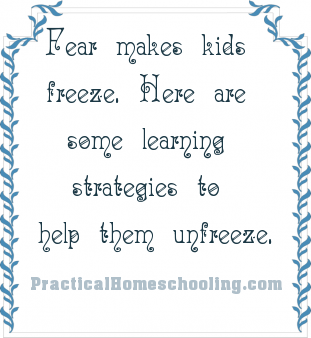Laughter and Movement: Fertilizer for the Brain
By Jessica Hulcy
Printed in Practical Homeschooling #60, 2004.
 Fear makes kids freeze. Here are some learning strategies to help them unfreeze.
Fear makes kids freeze. Here are some learning strategies to help them unfreeze.

|
 |
 If 100 random people were assembled and asked to draw a picture of a "school" setting, every picture would have students sitting at a desk either reading or writing, because those two activities represent school to the vast majority of Americans. But you can bet there would be another common denominator between all the pictures, and that would be serious faces on all the students going about their work in silence. Yet, current research shows this typical school setting is not the best way to enhance learning and retention.
If 100 random people were assembled and asked to draw a picture of a "school" setting, every picture would have students sitting at a desk either reading or writing, because those two activities represent school to the vast majority of Americans. But you can bet there would be another common denominator between all the pictures, and that would be serious faces on all the students going about their work in silence. Yet, current research shows this typical school setting is not the best way to enhance learning and retention.
Memory Blockers
The latest brain research has identified cortisol, the hormone released in the brain during stressed or agitated states, as the one brain chemical that prohibits information from sticking in the memory areas of the brain. Cortisol is released during times of stress and anxiety into the brain by the adrenal gland. Cortisol functions as God's protection to keep one from having bad memories following a stressful encounter by blocking memory, but it acts as weed killer to learning. A mother who dashes into a burning house to pull her baby from the flames may have no recollection of going into the house at all. When asked to describe her heroic feat, she may respond, "I don't remember."
Cortisol is also released into the brain when children are trying to learn under stressful conditions. If a mother calls her daughter to breakfast with a light, cheery voice from the kitchen by saying, "Lisa, time for breakfast!" Lisa will happily and confidently dash in to the kitchen for her morning meal. On the other hand, if she calls through gritted teeth in staccato tones, "Lisa Ann Hamilton, come here this second!" Lisa immediately discerns anger in her mother's voice. Adrenaline is dumped into her body and cortisol is released into her brain. Her eyes dilate, her muscles tense, and her heart races. She sorts through her memory trying to recall a forgotten chore, an incomplete school assignment, or a problem with a sibling. She is torn between "facing the music" and tearing out the back door to save her skin. She is in "fight or flight" mode.
The same physiological episode occurs when a mother holds up a math flash-card with 7 x 7 on it and quietly asks, "Tommy, what is 7 x 7?" If Tommy cannot think of the answer, even though he has been practicing his 7's for two weeks, he starts to get a little bit anxious. When she asks again through gritted teeth, "What is 7 x 7, Tommy?" his rising anxiety level senses the teacher's displeasure. His system dumps adrenaline into his blood-steam and cortisol into the brain. Cortisol blocks brain activity and thinking as Tommy downshifts from the logical, thinking part of the brain called the cerebral cortex to a lower level of the brain, called the limbic system. The limbic system houses emotions, and fear has taken hold of Tommy's brain. Very little rational, cognitive thought occurs in the limbic part of the brain. At this point, Tommy can no more remember 7 x 7 = 49 than the heroic mother can remember saving her baby from the burning house.
 Movement + Laughter = Brain Fertilizer
Movement + Laughter = Brain Fertilizer
What can turn this scene of non-learning to a scene of learning? Laughter and movement. Brain research documents that simple movement which breeds fun and laughter releases the amino acid GABA in the brain which then acts as a neurotransmitter. GABA, gamma amino butyric acid, is our natural Valium acting like a sponge, soaking up excess adrenaline and cortisol leaving the body relaxed. GABA seems to drain tension out of the body and brain thus giving students a sense of well- being which, in turn, fosters learning. Without the adrenaline and cortisol, the brain and body are ready to learn.
Homeschooling is a daunting task for any mother to undertake. The key to stimulating learning is a stress-free environment filled with smiles, laughter, and movement. Movement and laughter create an atmosphere in which kids love the learning process and willingly read more about the topic and write more about their experiences. As good teachers and concerned parents, we want our children to be lifetime learners who enjoy the education process. We want them to feel like learning is fun, not drudgery. We want them to be excited and anxious to find out what cool thing they are going to study next.
Is your school filled with laughter? Are your kids excited about learning new things each day? Does your curriculum help you to be a great teacher who makes learning joyful, exciting, and fun? It is time to start releasing fertilizer, not weed-killers, in our children's growing brains!